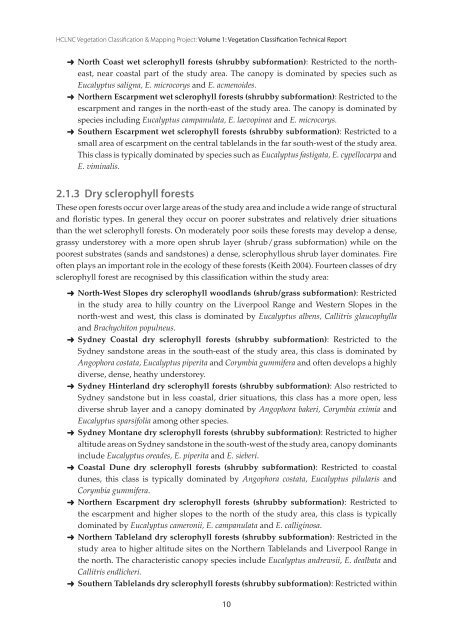Free Download - HCCREMS
Free Download - HCCREMS
Free Download - HCCREMS
Create successful ePaper yourself
Turn your PDF publications into a flip-book with our unique Google optimized e-Paper software.
HClNC Vegetation Classification & mapping Project: Volume 1: Vegetation Classification Technical Report<br />
➜ north Coast wet sclerophyll forests (shrubby subformation): Restricted to the northeast,<br />
near coastal part of the study area. The canopy is dominated by species such as<br />
Eucalyptus saligna, E. microcorys and E. acmenoides.<br />
➜ northern escarpment wet sclerophyll forests (shrubby subformation): Restricted to the<br />
escarpment and ranges in the north-east of the study area. The canopy is dominated by<br />
species including Eucalyptus campanulata, E. laevopinea and E. microcorys.<br />
➜ Southern escarpment wet sclerophyll forests (shrubby subformation): Restricted to a<br />
small area of escarpment on the central tablelands in the far south-west of the study area.<br />
This class is typically dominated by species such as Eucalyptus fastigata, E. cypellocarpa and<br />
E. viminalis.<br />
2.1.3 Dry sclerophyll forests<br />
These open forests occur over large areas of the study area and include a wide range of structural<br />
and floristic types. In general they occur on poorer substrates and relatively drier situations<br />
than the wet sclerophyll forests. On moderately poor soils these forests may develop a dense,<br />
grassy understorey with a more open shrub layer (shrub / grass subformation) while on the<br />
poorest substrates (sands and sandstones) a dense, sclerophyllous shrub layer dominates. Fire<br />
often plays an important role in the ecology of these forests (Keith 2004). Fourteen classes of dry<br />
sclerophyll forest are recognised by this classification within the study area:<br />
➜ north-West Slopes dry sclerophyll woodlands (shrub / grass subformation): Restricted<br />
in the study area to hilly country on the Liverpool Range and Western Slopes in the<br />
north-west and west, this class is dominated by Eucalyptus albens, Callitris glaucophylla<br />
and Brachychiton populneus.<br />
➜ Sydney Coastal dry sclerophyll forests (shrubby subformation): Restricted to the<br />
Sydney sandstone areas in the south-east of the study area, this class is dominated by<br />
Angophora costata, Eucalyptus piperita and Corymbia gummifera and often develops a highly<br />
diverse, dense, heathy understorey.<br />
➜ Sydney hinterland dry sclerophyll forests (shrubby subformation): Also restricted to<br />
Sydney sandstone but in less coastal, drier situations, this class has a more open, less<br />
diverse shrub layer and a canopy dominated by Angophora bakeri, Corymbia eximia and<br />
Eucalyptus sparsifolia among other species.<br />
➜ Sydney Montane dry sclerophyll forests (shrubby subformation): Restricted to higher<br />
altitude areas on Sydney sandstone in the south-west of the study area, canopy dominants<br />
include Eucalyptus oreades, E. piperita and E. sieberi.<br />
➜ Coastal dune dry sclerophyll forests (shrubby subformation): Restricted to coastal<br />
dunes, this class is typically dominated by Angophora costata, Eucalyptus pilularis and<br />
Corymbia gummifera.<br />
➜ northern escarpment dry sclerophyll forests (shrubby subformation): Restricted to<br />
the escarpment and higher slopes to the north of the study area, this class is typically<br />
dominated by Eucalyptus cameronii, E. campanulata and E. calliginosa.<br />
➜ northern tableland dry sclerophyll forests (shrubby subformation): Restricted in the<br />
study area to higher altitude sites on the Northern Tablelands and Liverpool Range in<br />
the north. The characteristic canopy species include Eucalyptus andrewsii, E. dealbata and<br />
Callitris endlicheri.<br />
➜ Southern tablelands dry sclerophyll forests (shrubby subformation): Restricted within<br />
10


